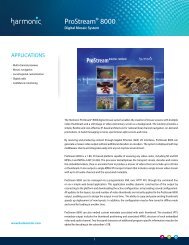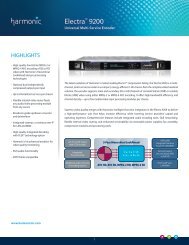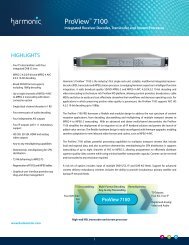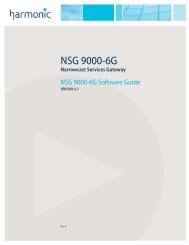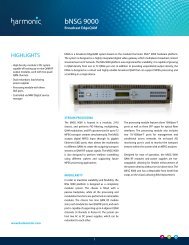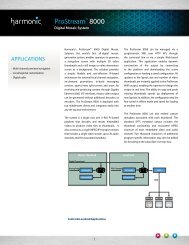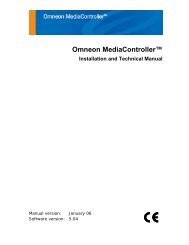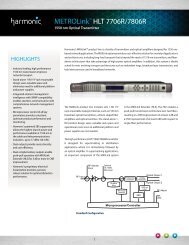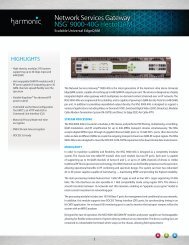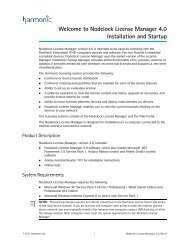About Omneon MediaGrid - Harmonic Inc
About Omneon MediaGrid - Harmonic Inc
About Omneon MediaGrid - Harmonic Inc
You also want an ePaper? Increase the reach of your titles
YUMPU automatically turns print PDFs into web optimized ePapers that Google loves.
System Configuration<br />
• ReadAhead. This parameter controls the amount of ReadAhead memory used by each<br />
open/active file. Units are in slices. The default value is 2 slices (Mac) or 3 slices (Windows/Linux)<br />
of memory for each open/active file. Reducing this number allows more simultaneous<br />
open/active files with the same amount of memory. However, reducing this number also reduces<br />
the bandwidth performance for each file, both read and write. When many files are open/active<br />
simultaneously, no single file has high performance, so this value can be reduced without<br />
detriment in that situation.<br />
• Cache Memory Limit. The FSD allocates memory for buffering cache from a single pool, the<br />
cache memory limit. When the FSD exceeds this limit, it begins to free memory until its usage is<br />
below this number. This limit defaults to 200MB on Linux and Mac OS X. The size of this limit<br />
on Windows changes dynamically based on the operating system version and physical RAM. The<br />
default value should be sufficient for clients with connectivity up to 1GBit/sec. Advanced users,<br />
depending on the workflow and if the client is capable of higher bandwidth (for example,<br />
10GBit/sec), who wish to utilize more bandwidth might consider increasing this value.<br />
When writing to a file, the readahead value specifies the number of parallel writes made to <strong>Omneon</strong><br />
<strong>MediaGrid</strong> servers. Table 3 provides information on how changes to the ReadAhead parameter<br />
affects performance.<br />
Table 3. Performance Considerations<br />
Parameter <strong>Inc</strong>rease Decrease<br />
CacheReadAhead Pros<br />
• <strong>Inc</strong>reases read throughput<br />
• <strong>Inc</strong>reases write throughput<br />
Specifying Buffer Memory for Macintosh Clients<br />
To configure the amount of memory used for ReadAhead buffering:<br />
1. Type the following command:<br />
mount –t omfs /mediagrid/filesys /mnt<br />
-o username=username,password=password,readahead=2<br />
The memory used is specified in units of slices.<br />
2. Set the memory to the desired value.<br />
Cons<br />
• <strong>Inc</strong>reases latency on random<br />
read<br />
• <strong>Inc</strong>reases memory usage<br />
Pros<br />
• Decreases memory usage<br />
• Decreases latency on random<br />
read<br />
Cons<br />
• Decreases read throughput<br />
• Decreases write throughput<br />
The above command reserves 2 slices worth of memory for each file that is opened (2 slices for<br />
ReadAhead buffers). For files using a slice size of 8MB, the above command would reserve 16MB of<br />
memory per file. Reducing this value increases the number of simultaneously active files an application<br />
can use, but reduces performance. <strong>Inc</strong>reasing it may improve performance for some workflows.<br />
See the latest <strong>Omneon</strong> <strong>MediaGrid</strong> Release Notes for Macintosh FSD for the currently supported range of<br />
readahead values.<br />
132 Installation and Configuration Guide



